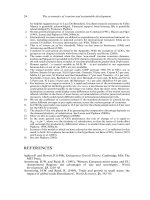THE ECONOMICS OF MONEY,BANKING, AND FINANCIAL MARKETS 371
Bạn đang xem bản rút gọn của tài liệu. Xem và tải ngay bản đầy đủ của tài liệu tại đây (43.49 KB, 1 trang )
CHAPTER 13
where
DURgap
i
i
Thus
Banking and the Management of Financial Institutions
duration gap
change in interest rate
interest rate
*NW
A
1.72
0.11
1
0.10
0.01
0.10
339
1.72
0.01
0.10
0.016
1.6%
With assets totalling $100 million, this Application indicates a fall in the market
value of net worth of $1.6 million, which is the same figure that we found in the
previous Application.
As our example makes clear, both gap analysis and duration analysis indicate that
First Bank will suffer if interest rates rise, but will gain if they fall. Duration analysis
and gap analysis are thus useful tools for telling a financial institution manager the
institution s degree of exposure to interest-rate risk.5
A PP LI CATI O N
Strategies for Managing Interest-Rate Risk
Suppose that as the manager of the First Bank, you have done a duration and gap
analysis for the bank as discussed in the text. Now you need to decide which alternative strategies you should pursue to manage the interest-rate risk.
If you firmly believe that interest rates will fall in the future, you may be willing to take no action because you know that the bank has more rate-sensitive liabilities than rate-sensitive assets and so will benefit from the expected interest-rate
decline. However, you also realize that the First Bank is subject to substantial
interest-rate risk because there is always a possibility that interest rates will rise
rather than fall. What should you do to eliminate this interest-rate risk? One thing
you could do is to shorten the duration of the bank s assets to increase their rate
sensitivity. Alternatively, you could lengthen the duration of the liabilities. By this
adjustment of the bank s assets and liabilities, the bank s income will be less
affected by interest-rate swings.
One problem with eliminating the First interest-rate risk by altering the balance
sheet is that doing so might be very costly in the short run. The bank may be
locked into assets and liabilities of particular durations because of where its expertise lies. Fortunately, recently developed financial instruments known as financial
derivatives financial forwards and futures, options, and swaps can help the
bank reduce its interest-rate risk exposure but do not require that the bank
rearrange its balance sheet.
5
Gap analysis and duration analysis apply equally to other financial institutions. A second web appendix to this chapter applies gap and duration analyses to a nonbank financial institution; it can be found
on the book s MyEconLab at www.pearsoned.ca/myeconlab.









